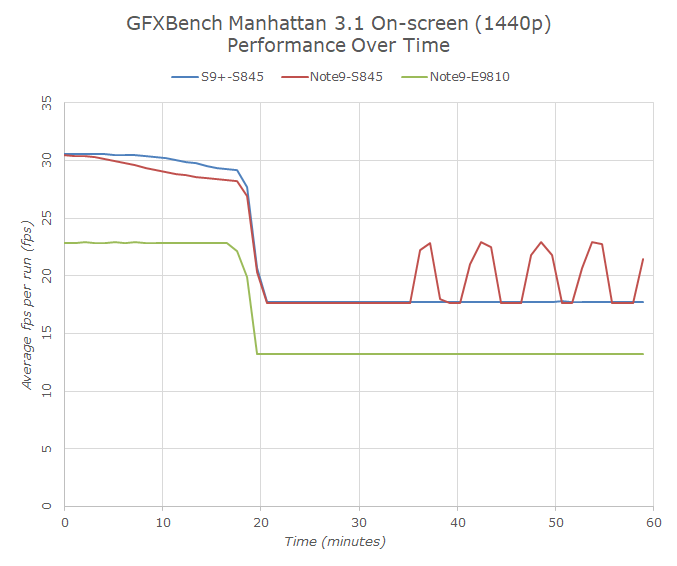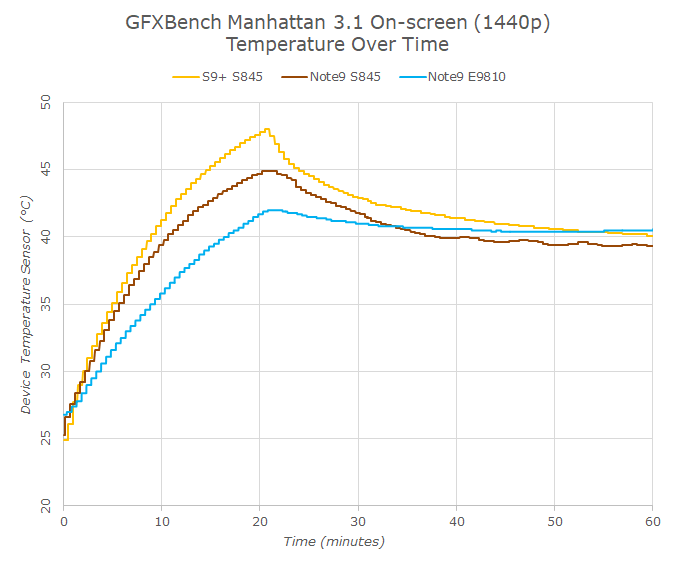Samsung Galaxy Note9 Performance & Battery Showdown: Snapdragon vs Exynos
by Andrei Frumusanu on November 26, 2018 8:00 AM ESTGPU Performance & Device Thermals
GPU performance of the Note9 shouldn’t be much of a surprise by now as we’ve covered the Snapdragon 845 and Exynos 9810 extensively in this regard. Yet, the Note9 does differ significantly in this regard because Samsung claims to have included a new massive heat-pipe and heat spreader, theoretically much improving the thermal dissipation from the SoC to the body of the phone.
I’m actually starting off this article with a test of the device’s thermals, because I found some quite weird results here that I feel are quite inexplicable in their behaviour, and something that I found to happen in quite a lot of the Snapdragon 845 devices in 2018.
I’m using the on-screen Manhattan 3.1 test in 1440p on-screen mode in a continuous loop for an hour. Besides both Note9’s, I’m also including the S9+ in order to see just how much of an effect the Note9’s new heat-pipe is able to help with performance and thermals.
Performance wise, the results are very surprising. The Snapdragon Note9 for the better part of the first 20 minutes seems to actually perform slightly worse than the S9+. Both phones look to be throttling at virtually the same identical point, which I also found to be quite weird. It’s only much later in the test, after the 35 minute mark, where the Note9 starts to fluctuate more in terms of performance, recovering to a higher GPU frequency for a few minutes before falling back to the minimum performance and continuing so forth ad infinitum.
The Exynos Note9 as expected, performs worse than the Snapdragon unit, but this shouldn’t be much of a surprise.
Actually examining the temperature reported by the phones we again see some very weird behaviour. The temperature here is as reported by an internal sensor on the phones. I don’t usually like showcasing these results because the sensors will vary between devices and vendors. This case is an exception because the sensor between the two Note9’s should be identical (battery PMIC IC), as well as very comparable to the S9+. The actual maximum skin temperature as measured by an IR thermometer are higher than the values shown here.
The one thing that again feels utterly unexplainable to me is the fact that there’s a notable change in throttling behaviour after the 20 minute mark, all seemingly unrelated to the actual temperature of the phones. The Snapdragon Note9 does report much better maximum temperatures over the S9+. The Exynos Note9 here also achieves even better temperatures, and this pretty much falls in line with the fact that the Exynos 9810’s peak power consumption in GPU workloads is actually lower than the Snapdragon 845’s.
Now this 20 minute mark in the temperatures is something that I’ve encountered more often this year across devices, yet I haven’t actually found any good evidence as to explain it. The Snapdragon Note9 showcases that it has intermediate throttling levels later on in its runtime, what puzzles me is as to why the device doesn’t set this medium frequency level earlier in the runtime when reaching the same throttling temperature?
The Snapdragon 845’s behaviour here is very weird: In our initial review of the Galaxy S9+ I mentioned that the phone entered an overheating state killing the benchmark, reaching high skin temperatures of up to 58°C. In subsequent firmware updates over the summer I wasn't able to reproduce this anymore. I actually found the same issue in the Xiaomi Mi MIX2S which was also quickly resolved with a firmware update. This lets me believe that Qualcomm actually has some sort of time-, rather than a temperature-based boost/throttle mode in the drivers of the chip. I’m very perplexed by this as I can’t discern if this is a legitimate mechanism or not.
The benchmarks
The thermal considerations being mentioned, we continue on with our standard set of benchmarks.

In the 3DMark Physics test, the Note 9 fares extremely well in terms of the sustained performance scores. Here we see quite a jump over the results of the S9+, and at the same time this makes the Snapdragon Note9 the best S845 device in this particular benchmark.
The Exynos Note9 also showcases much improved sustained performance scores much higher than that of the S9.

The 3DMark graphics results have me a bit perplexed. The Snapdragon Note9’s sustained performance scores are good- really good- too good.
We showcased that the devices do throttle after certain amount of time, yet in 3DMark I wasn’t able to actually enter this sustained state in any way on the Note9’s, even after prolonged heating. I don’t have a way to loop 3DMark in the same way I loop GFXBench, and I have to wonder if this plays a role here. The Snapdragon Note9 was allowed to get really hot here, reaching 48°C+ skin temperatures near the SoC.
I’m using obfuscated applications IDs to avoid benchmark detection – still I have some reservations about these scores on whether they’re results of genuine thermal mechanisms or something else.


Moving on to GFXBench, we’re seeing some more reasonable sustained performance results in the “High” benchmark mode. Again I have a hard time explaining why the Normal mode scores that much better for the Snapdragon Note9, here it’s maybe a side-effect of the higher ALU utilisation in the high mode which also causes higher power consumption in the Adreno 630.

In Manhattan, we see a similar result as in the Normal Aztec run, with the Snapdragon 845 Note9 maintaining excellent sustained perf.

Switching over to T-Rex, things again are more in line with previous Snapdragon 845 results. The Exynos Note9 also is behaving very similar to the S9.
I’ve ran these tests several times now and again noticed there some unexplained variability in the results that aren’t explained by the actual temperature of the phones. Under thermal stress, the Snapdragon Note9 sometimes performs excellently even at high sustained temperatures of the device, and sometimes it logically throttles as you would expect it to. It’s something I’ll have to dig in a bit more into.
In any case, the verdict here is that the Snapdragon Note9 performs excellently in terms of sustained performance. The Exynos Note9’s sustained performance in GFXBench was a lot more alike the S9 – both devices allowing for much lesser peak temperatures than the Snapdragon counterparts, but again both also showcasing significantly worse performance due to the weaker GPUs.












69 Comments
View All Comments
Andrei Frumusanu - Monday, November 26, 2018 - link
> Please kindly do mention the workings of them.It's a bit too much to cover as it goes into the actual registers of the fuelgauge and the battery drivers. In general you can just read up on Maxim's ModelGauge algos.
https://www.maximintegrated.com/en/design/partners...
> To add my OP3 fuel gauge chip also blocks installing the 3Ts higher spec battery (3000 vs 3300)
In general kernels can't do anything because the PMIC/FG is initialised by the bootloader, which is again a whole other topic.
Quantumz0d - Monday, November 26, 2018 - link
Thanks, that should help. Yes, OnePlus patched it with a firmware update iirc.eastcoast_pete - Monday, November 26, 2018 - link
@Andrei: Thanks for this review and the analysis. I know you wouldn't write this w/o strong, more direct evidence, but would you care to speculate on how the strange behavior of the snapdragon Note 9 in the graphics benchmark (allowing temp to rise quite high) might affect battery longevity (actual useful lifetime, as in number of charges before it degrades)? I for one am concerned whenever a Li-ion device is allowing itself to get quite toasty. Lastly, there is also the suspicion that Samsung has massaged the SoC software to recognize GFx and Aztec and allow a "performance mode" when these are detected.Regarding Samsung's insistence of using its S-LSI in-house Exynos whenever possible: I am not even sure that it ends up costing Samsung that much less than using QC's 845. I believe it's a case of what in banking is called throwing good money after bad, i.e. the reluctance to say "well, this (Exynos/Mongoose) didn't work out", and move one. Until the most recent Kirin, the Android mobile SoC landscape really had two players: QC and Samsung. If you lived in a country that only gets the Exynos, there were few competitive non-Exynos handsets to have at the higher end. However, the competitive landscape has changed, with the newest A-76 Kirin designs giving Samsung a run for its money. I wonder if the desire to move $ 800 - $1100 handsets will overcome Samsung's reluctance to use QC flagship SoCs for Europe and Asia also. Otherwise, they're in for a world of hurt. I would be surprised if Huawei isn't working on a pen-input device based on its P 20 Pro to go after the upcoming Note 10.
Andrei Frumusanu - Monday, November 26, 2018 - link
> I know you wouldn't write this w/o strong, more direct evidence, but would you care to speculate on how the strange behavior of the snapdragon Note 9 in the graphics benchmark (allowing temp to rise quite high) might affect battery longevity (actual useful lifetime, as in number of charges before it degrades)?As you say, I don't have any data on this and can't say anything other than it gets hotter than it should be allowed to. In most games it's not an issue but that's besides the point.
eastcoast_pete - Tuesday, November 27, 2018 - link
Thanks Andrei! I was really surprised by Samsung's apparent willingness to have the 845 Note heat up to levels that one usually wants to avoid when dealing with Li-ion batteries. Especially given the debacle they had with the battery malfunction in their Note 8. At least for here in the US, they have just opened themselves up for a class-action lawsuit if Note 9s have battery issues also. It can now be argued that any damages to the battery are due to defective software that allows overly high temperatures, resulting in premature failure.HStewart - Monday, November 26, 2018 - link
I am curious about Note 8 compared to Note 9 on your comparison list.With my Note 8 the OS detects which applications use the batter. One thing is sure, when I switch iPhone 6 to Note 8, I used my phone a lot more.
HStewart - Monday, November 26, 2018 - link
Just to be clear - not on specs which was listed - but on performance battery life and …For me the phone is fast enough - how much performances does one need - battery life is different story
But the battery life on Galaxy Watch is a total different story, I get almost a week on it.
Andrei Frumusanu - Monday, November 26, 2018 - link
We never had a Note8 to test.FrankSchwab - Monday, November 26, 2018 - link
Probably because, as long as they have a viable second-source, they can beat up on QC to keep the price of the Snapdragon low. "You want how much for 50 million Snapdragons? That's too much. We'll buy a few at that price - say, 20 million - just to keep our relationship intact, and use our Exynos for the other 30 million".Iczeman - Monday, November 26, 2018 - link
Wow, what a disappointment of Exynos performance of S9. Really pity that on European market is not Snapdragon version available as much worth for the same money. Hopefully with S10 will get difference smaller but it's only wish for several years already.